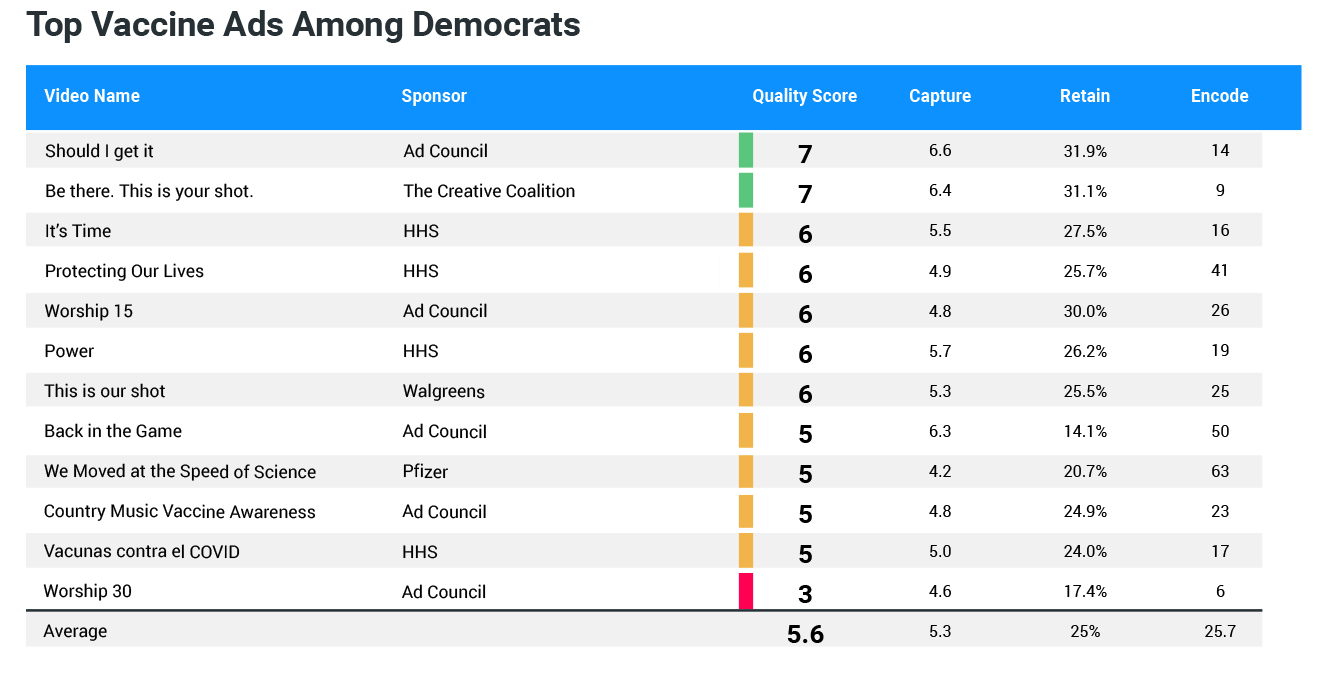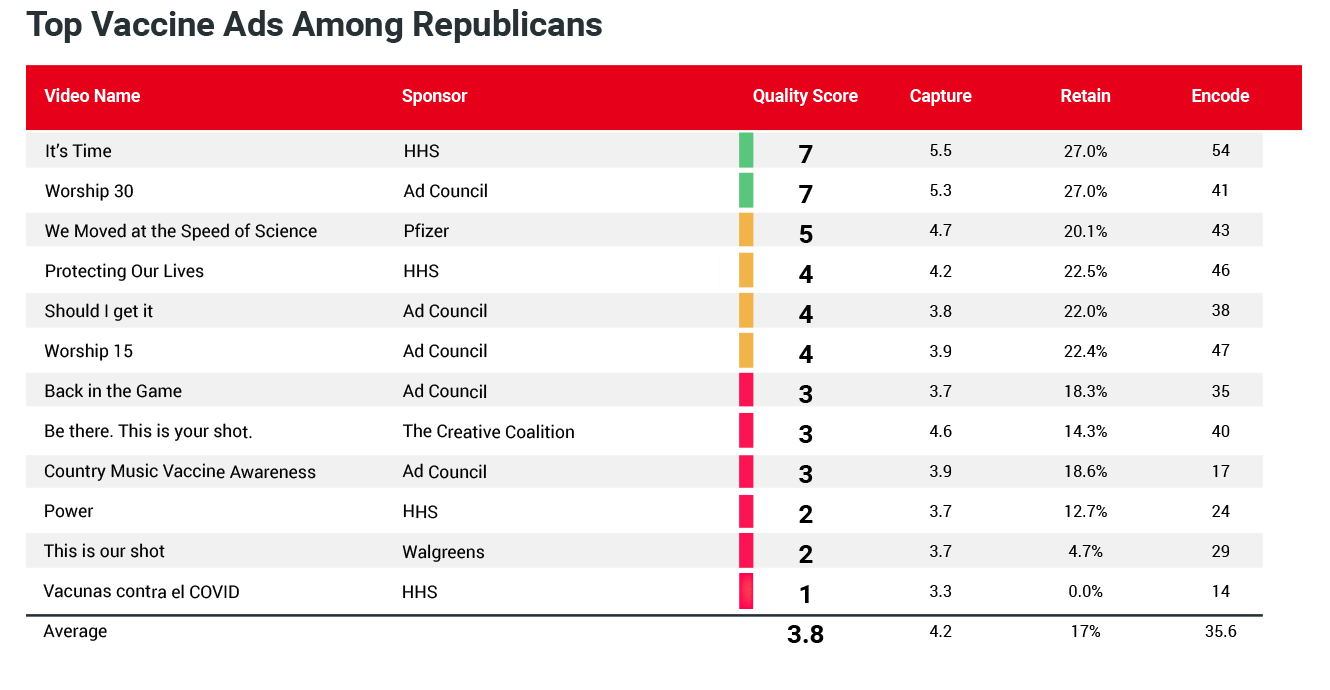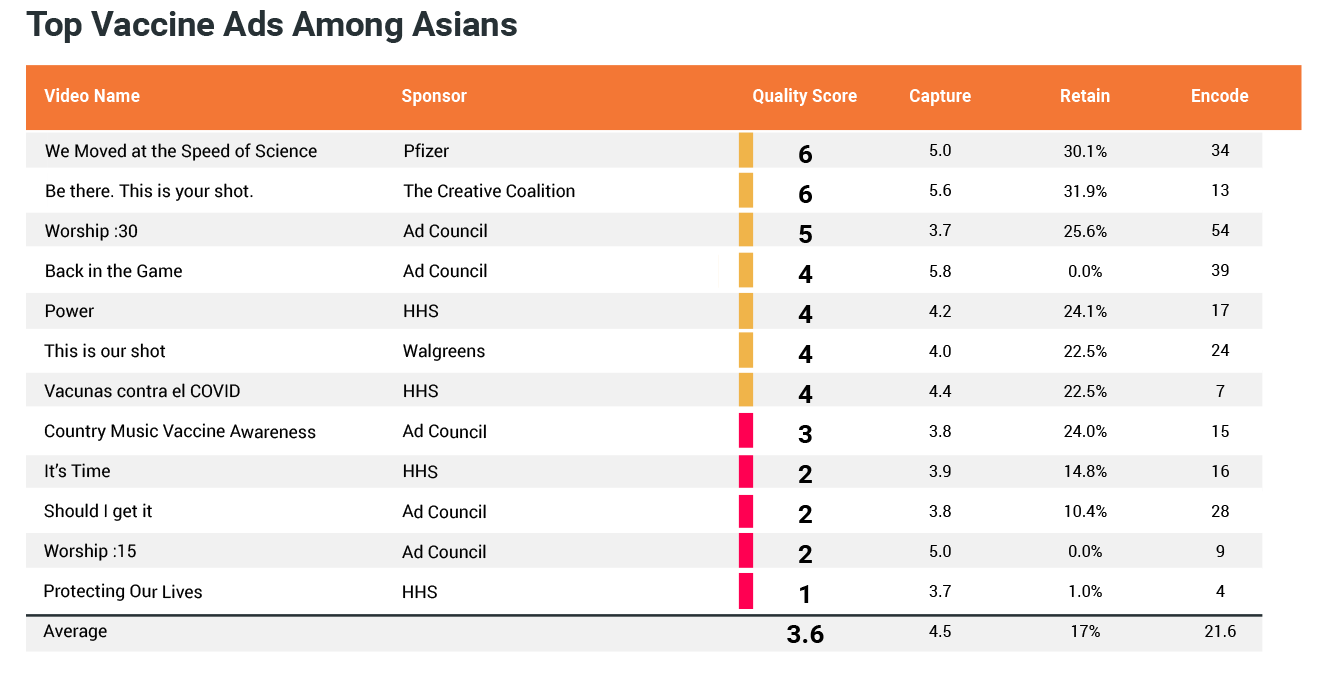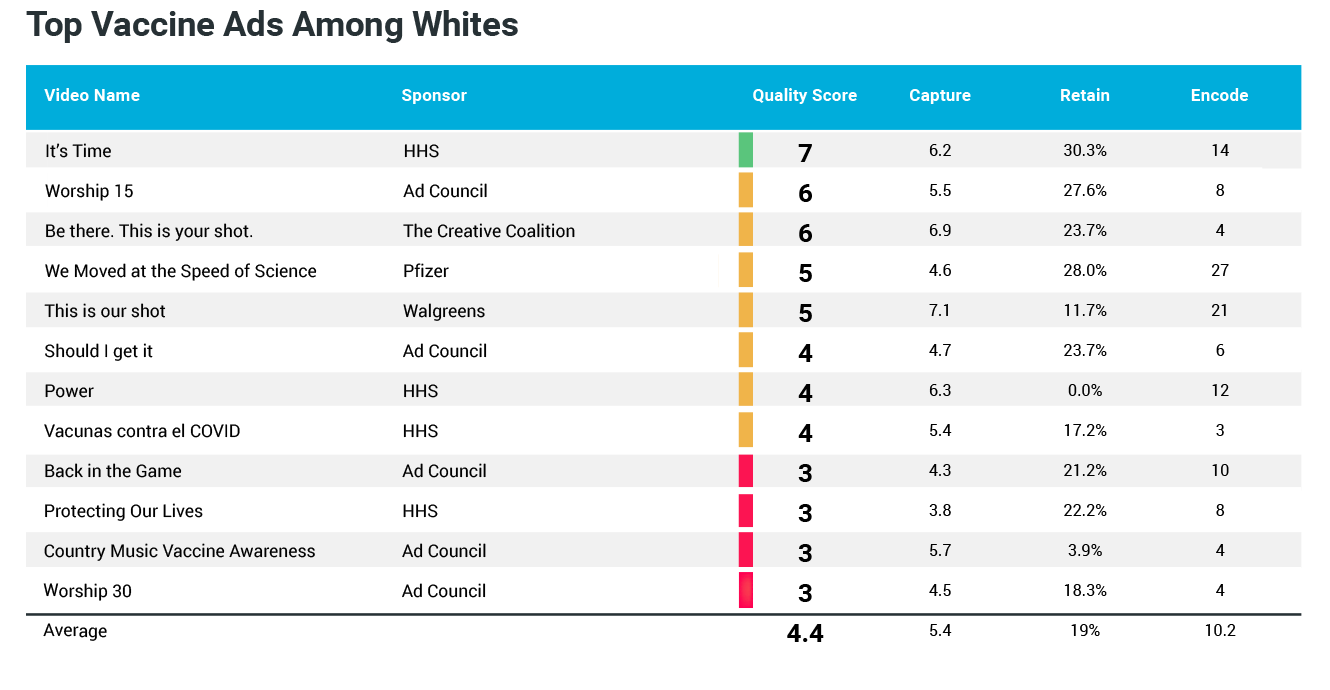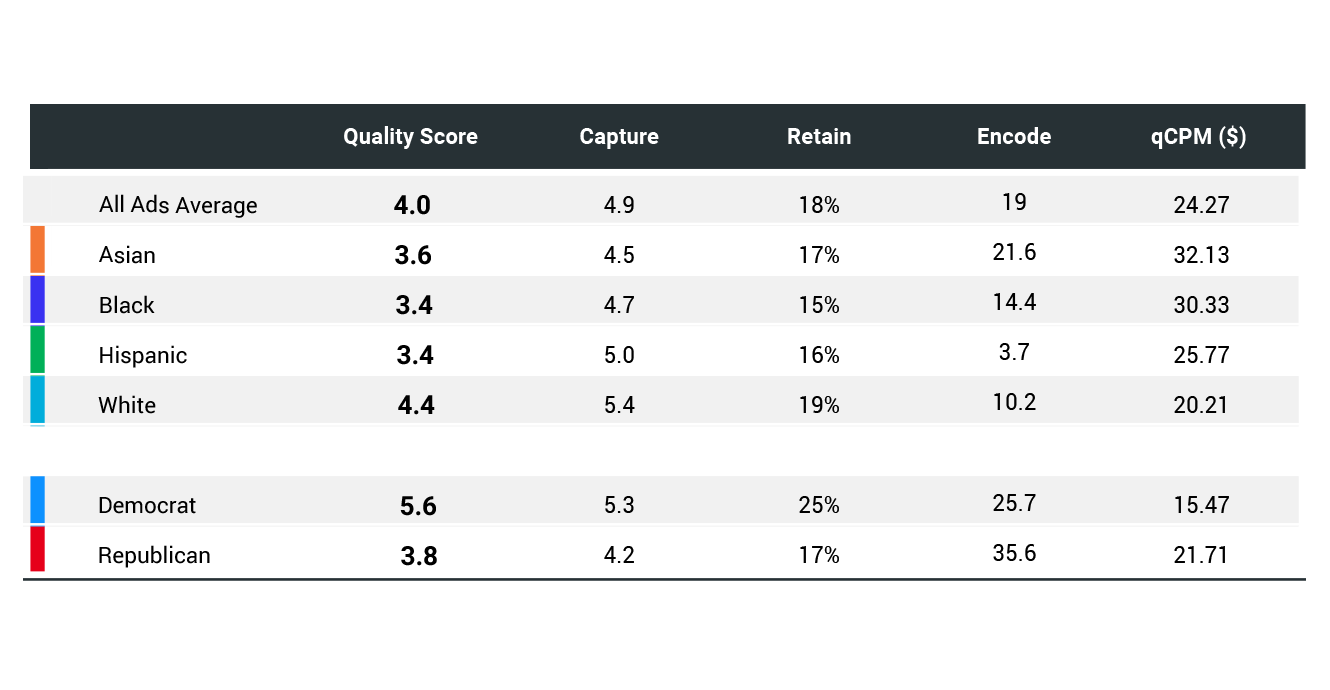Executive Summary
Attention to Vaccine Ads Varies Widely Across Race and Political Party
A single video creative asset can create extraordinary differences in the cost to achieve high-quality exposures of vaccine messaging to different audience segments
What You Need to Know
There is a significant disparity in the resonance of vaccine ads among different racial and political groups as evidenced by Realeyes Quality Score.
The effective cost to message different racial and political groups with the same video creatives differs by up to 50% because of the creative quality.
To create more relevant messaging that connects with key audience segments in times of shifting sentiment, public service advertisers should consider native production techniques and agile production methods. Long term, they should consider increasing the diversity in creative teams.
To optimize campaigns before they launch, advertisers should take advantage of available tools to predict in-market attention and understand the effective cost to message critical public health information.

Max Kalehoff
Vice President of Marketing & Growth
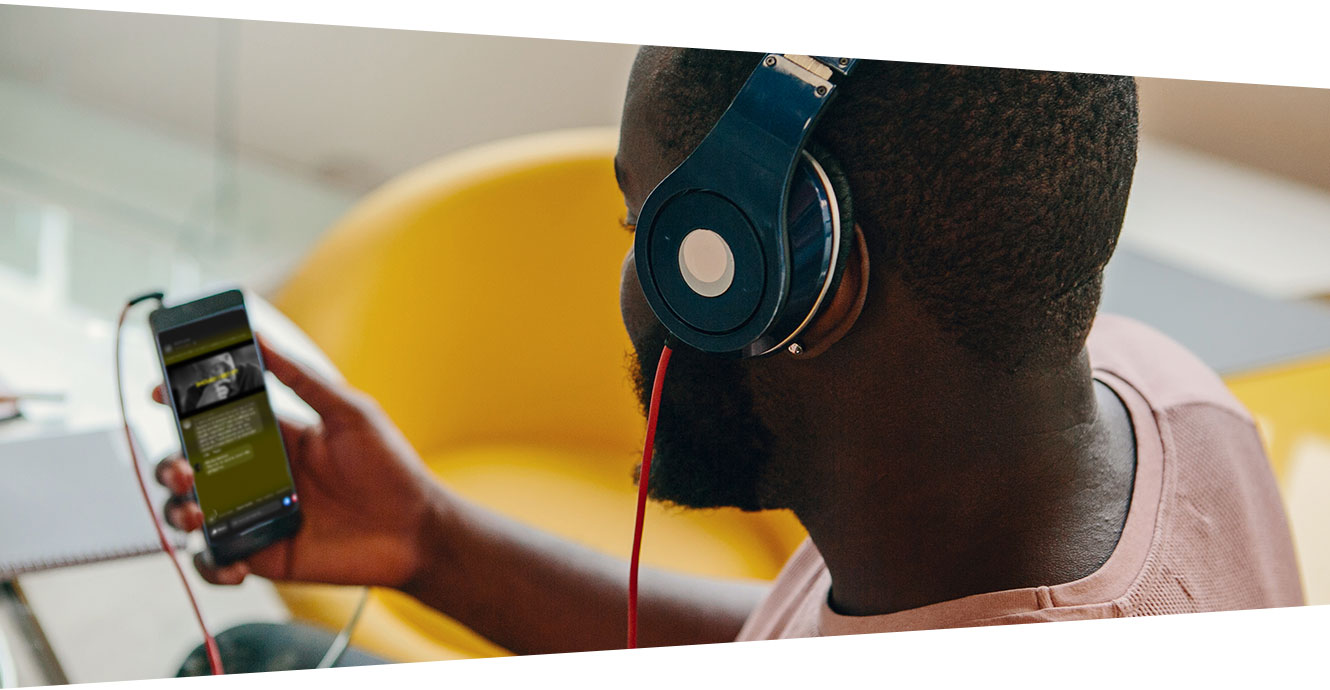
Background: Vaccine Rollout 2021
With the COVID-19 vaccine rollout well underway as of June 2021, the CDC and news services have noted that the racial makeup of vaccine recipients does not match the general population. The lag in minority uptake of the vaccine is at odds with a disease that disproportionately affects them in case counts and deaths. For example, in Colorado, 11% of vaccinations have gone to Hispanic people, while they account for 41% of cases, 25% of deaths, and 22% of the total population in the state. Source: Kaiser Family Foundation.
A disparity also exists in political affiliation; states that voted Democratic in the 2020 Presidential Election tend to be ahead of Republican states in the overall percentage of vaccinated individuals. An April 2021 survey showed that 43% of Republicans say they will avoid the vaccine, compared with just 5% of Democrats. Source: Monmouth University Poll,
Several entities have run advertising campaigns on TV and social media to encourage vaccine uptake—including the Ad Council, the U.S. Department of Health and Human Services (DHHS), Pfizer, and Walgreens. Some of these ads directly address minority groups, and most represent multiple races in each ad. However, disparities in vaccine uptake persist, and Realeyes sought to understand how these ads resonate with respective racial and politically affiliated groups.
To that end, we conducted a study examining twelve video ads across four racial groups: Black, Hispanic, Asian, and White. In addition, we tested the same twelve ads among self-identified Democrats and Republicans. Videos ranged in length from 15 to 45 seconds. Each ad was viewed on either a desktop or mobile device by an average of 164 study participants across each of the six groups between April 30 and May 19, 2021.
Data Highlights
Public service ads scored 38% higher in Quality Score among Democrats than Republicans. As a group, the vaccine ads were more successful at capturing and retaining the attention of Democrats than Republicans.
Ads targeted toward specific racial groups did not necessarily perform well with their respective target groups.
The Pfizer social media ad, “We Moved at the Speed of Science,” was the only ad to appear in the top five of nearly every racial group by Quality Score and received higher than average Retention scores. Given that storytelling from a vaccine manufacturer proved to be compelling, public health organizations may do well to partner with private entities on public service campaigns.
The single-shot Morgan Freeman Instagram ad, “Be there. This is your shot,” from the Creative Coalition, performed well across many groups. This high performance relative to the other ads may indicate that public service advertisers can find success with a low-budget production approach using likable celebrities’ donated time.
The effective cost of quality media exposures, due to the efficiency of the video creatives, differs across racial groups by up to 50%; the effective cost of quality media exposures, among the average of all ads tested, differs across Democrats and Republicans by 40%.
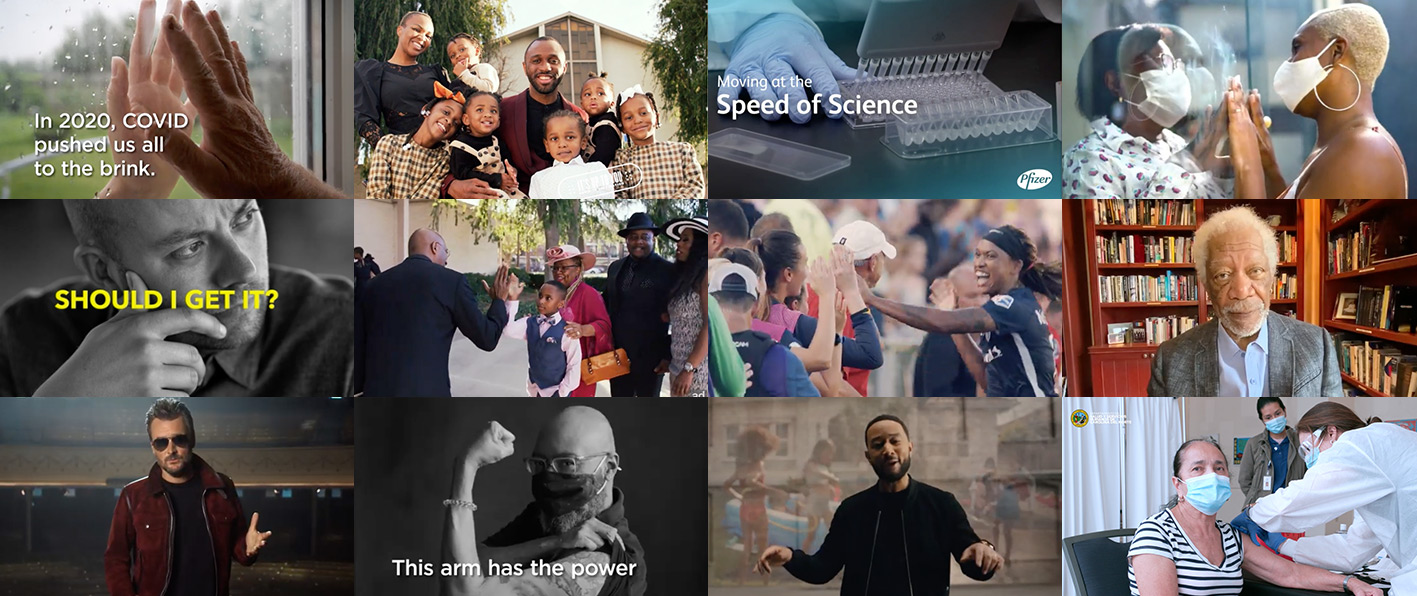
Methodology & Definitions
Our study tested twelve video public service ads that appeared on TV and social media among six discrete groups with an average of 164 viewers per video: Democrat, Republican, Asian, Hispanic, Black, and White.
Using Realeyes’ flagship PreView attention-measurement product, each ad received a Quality Score, a rating of 0-10, which measures a video’s ability to perform live in market. Quality Score factors in three critical elements:
1) Capture
Ability to capture audience attention in the first seconds.
The Realeyes Capture score measures how long viewers stayed engaged with the ad before looking away. The average benchmark median capture score across this group of ads was 5.7 seconds before the first distraction.
2) Retain
Ability to retain the audience throughout the ad.
The Realeyes Retain metric is defined by the percentage of users paying attention through the second 15, or until the end of the video if it is shorter than 15 seconds. The median retention benchmark percentage was around 25% through the 15th second for this ad group.
3) Encode
Ability to encode the brand message into the brain through emotional engagement.
The Realeyes measure of Encoding, also called Attention Potential, is an index between 0-100 that indicates the presence of emotional peaks and valleys and predicts viewers’ propensity to become interested in an ad versus all other ads in a given ad’s industry benchmark. The benchmark median score is 50.
*PreView is a content intelligence tool for predicting and managing attention in advertising. PreView enables advertisers to reduce media waste by predicting and eliminating low-performing video creative and boosting strong attentive creative. PreView has achieved up to 30% performance gains and 9X return of investment based on an ROI model involving 51 actual consumer goods ads.
Vaccine Ads Engage Democrats Better than Republicans
In 2020, science became politicized, with COVID-19 statistics and the vaccine itself called into question by members of the Republican party. Most of the vaccine ads in our sample mentioned science and common sense while attempting to impart a hopeful emotional tone to motivate viewers.
Quality Score
With dominant vaccine enthusiasm among Democrats, it’s no surprise that the public service ads scored 38% higher among Democrats than Republicans in overall quality score.
The highest-scoring ads differed across political parties. “Should I get it,” from the Ad Council, and the Morgan Freeman ad “Be there. This is your shot,” from The Creative Coalition, each received a Quality Score of 7 among Democrats. Both ads contained a science-led message backed up by trust.
By contrast, the two highest-scoring ads among Republicans were “It’s Time,” from the DHHS, and the “Worship” 30-second spot, from the Ad Council. The respective sentimental and religious messages of these ads may have contributed to their ability to capture and retain attention among a conservative audience.
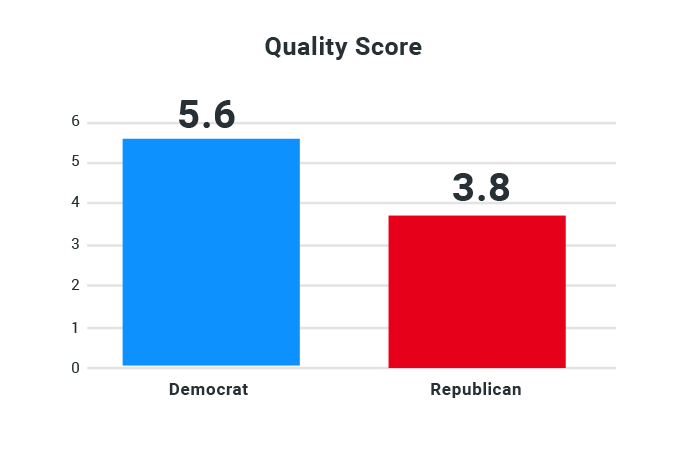
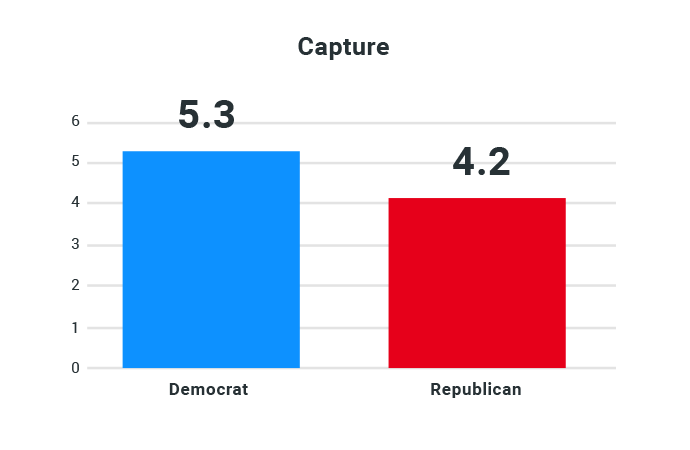
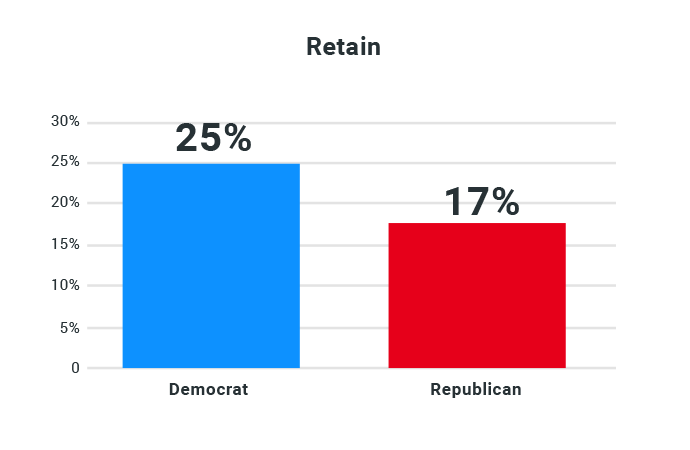
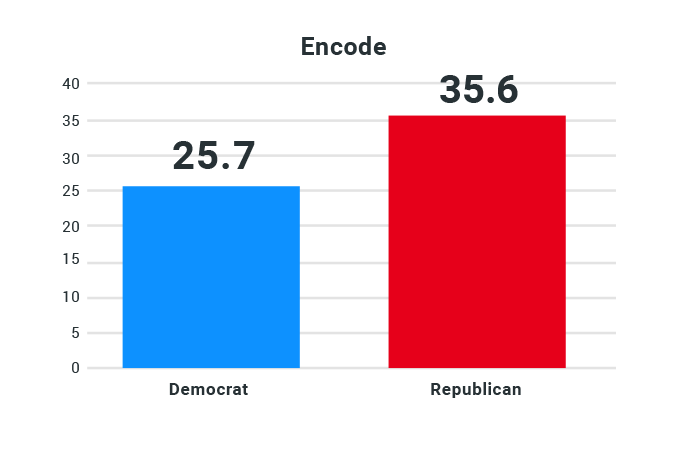
Capture
The vaccine ads held Democratic viewers’ attention for 1.1 seconds longer than Republican viewers, with the first distraction at 5.3 seconds for Democrats versus 4.2 for Republicans.
The highest-scoring ads among both groups were the same as those with the highest quality scores, demonstrating the importance of the first 5 seconds in determining whether a viewer will continue to watch an ad.
Retain
Democratic viewers were more likely to pay attention to the PSA ads through the fifteenth second than Republicans. One-quarter of Democratic viewers stayed with an ad through the second 15 versus 17% of Republicans.
The Ad Council’s science-led “Should I Get It” retained attention among Democrats the longest, with 32% of viewers staying engaged through the first 15 seconds.
Republicans were more likely to pay attention to the ads “It’s Time” from DHHS and “Worship,” the 30-second spot from the Ad Council. As mentioned, these scores indicate that a sentimental or religious tone can succeed in capturing the attention of Republicans.
Encoding
The increasing polarization of political parties is amplified by the media, leading to echo chambers of messaging that furthers each party’s agenda. Media channels appeal to emotional response, which could cause viewers to express negative emotions upon viewing ads that conflict with their beliefs.
Only two ads among Democrats met the threshold median score of 50 or higher for successful Encoding: “Back in the Game,” from the Ad Council, and “We Moved at The Speed of Science,” by Pfizer. “Back in the Game” was an appeal to the positive emotions of sports, while the Pfizer ad was an inspiring science-led message from a maker of the vaccine.
The sentimental ad “It’s Time,” from the DHHS, scored the highest in Encoding among Republicans, suggesting that evoking nostalgia is a successful way to achieve emotional response with that group.
Government, Health, and Pharma Advertisers Must Tailor Messaging & Targeting
The dominant middle-of-the-range quality scores (4-6) among Democrats and lower scores (0-3) among Republicans indicate room for improvement for public service vaccine ads. The variety of messages across the Ad Council and the HHS suggests that these entities knew they would have to address different aspects of vaccine skepticism and resistance. When combined with targeted media buys, ad spending could be optimized by selecting ads that directly address key aspects of vaccine resistance by political affiliation.
Ad Performance by Race
Quality Score
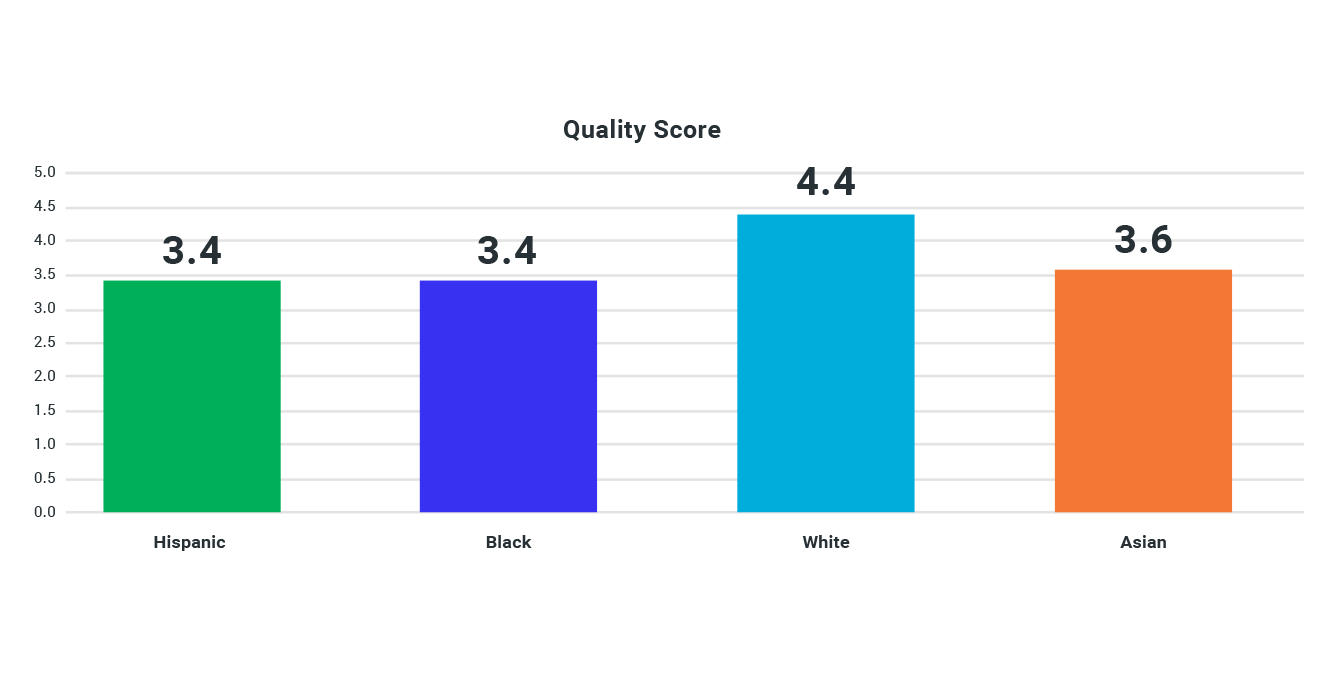
These scores reflect general feelings about advertising captured by other studies: An Adobe survey in 2019 found that only 26% of African-Americans, 10% of Hispanics and 3% of Asians feel represented in advertising, compared to 59% of whites. [1] And the ad industry suffers from a lack of racial diversity among its creative directors.
There is an overall lack of consistency in the top-scoring ads among each racial group. For example, the only ad that appeared in three of the four groups’ top 5 lists (Black, Asian, White) was the science-oriented Pfizer ad, “We Moved at the Speed of Science,” that featured a Hispanic grandparent couple, received a Quality Score of only 2 among Hispanic viewers.
Ads that prominently featured Black people (“Protecting our Lives,” “This is our shot,” “Worship,” and “Be there. This is your shot”) did not perform as well as could be expected among a Black audience. No ad received a Quality Score over five from the Black audience; the Pfizer ad, the multicultural “Power” ad from DHHS, and surprisingly, the all-Spanish ad “Vacunas contra el COVID” were among the top-scoring ads.The Hispanic-targeted ad did not perform highly with Hispanic viewers. It may have scored higher with other groups simply because of the compelling photos and the intrigue of watching an ad in another language.The Pfizer social media ad, “We Moved at the Speed of Science,” appeared in the top five of nearly every group by Quality Score and received higher than average Retention scores. Given that storytelling from a vaccine manufacturer proved to be compelling, public health organizations may do well to partner with private entities on public service campaigns.
[1] Forbes, Addressing The Ad Industry’s Sticky Problem With Race
Capture and Retain
White viewers were more attentive to the vaccine ads than other groups, showing the highest Capture and Retain scores. While race is not typically considered when testing ads, it may be a worthy factor to address for targeted campaigns.
It is possible that government PSAs have an inherent “white bias” that make them less effective at retaining the attention of minority groups. Creative choices such as casting, music, and narration all contribute to the overall impact and viewer interest in maintaining attention on a video ad.
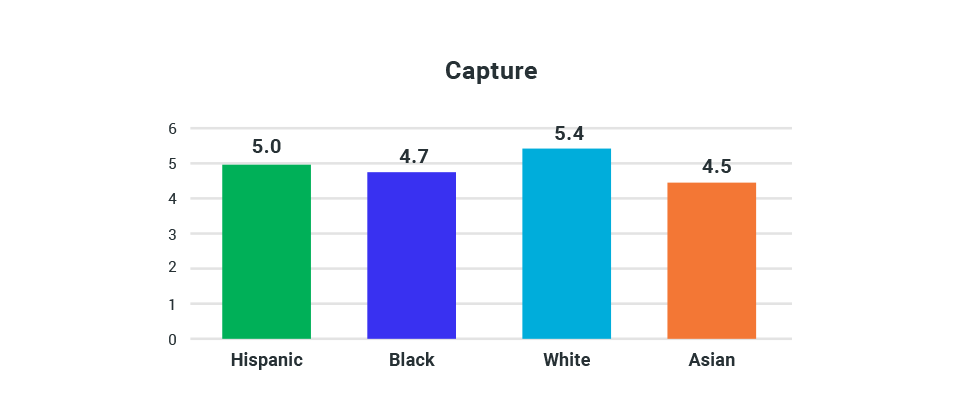
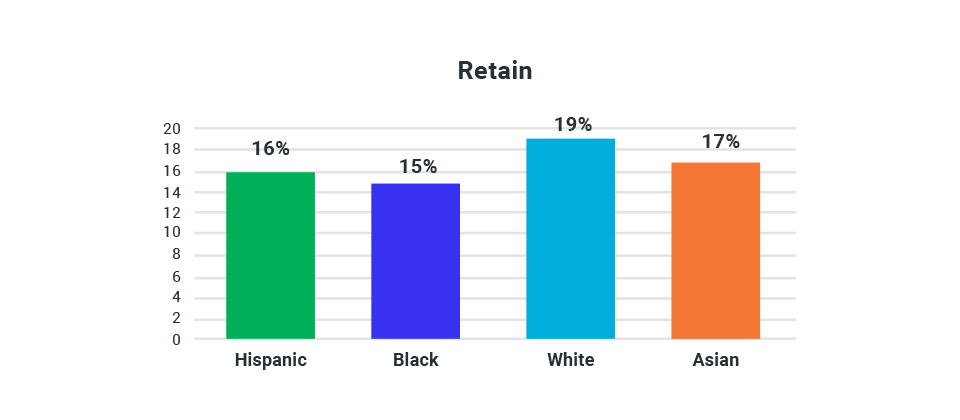
Encoding
Are people tired of being preached to? Several events in 2020 have brought racial disparities to light, and some members of minority groups have reported exhaustion with tokenism. Extraordinarily low encoding scores across all groups—including White viewers—suggest that these PSAs are not effective at bringing about any emotional response, positive or negative. Is a science-based argument too rational?
Realeyes Attention AI Encoding measures emotional response across a spectrum that includes ;happy,’ ‘confused,’ ‘negative,’ ‘disgusted,’ ‘sad,’ ‘scared,’ ‘surprise,’ and ‘contempt.’ The ad “Be There. This is your shot” scored highest for ‘happy’ among both White and Black viewers, suggesting that likable celebrities can reach across race lines—just as Morgan Freeman suggests in the ad itself.
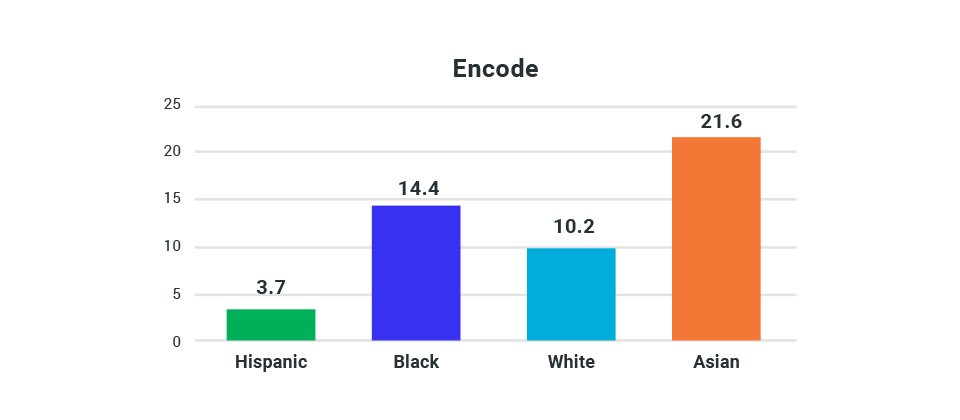
Influence of Creative On Effective Media Cost
The quality of a video creative directly impacts the quality of ensuing exposure when serving the ad via paid media. Realeyes’ creative ROI framework factors in Capture, Retain, and Encode scores to establish an effective cost per 1,000 quality media exposures, or a qCPM. (Download the High Price of Low Quality Video Advertising white paper for full white paper and methodology.)
In this study, we assigned a nominal video CPM value of $10 to demonstrate the creative’s influence on media cost across different audience segments. Among racial groups, qCPM was lowest among Whites at $20.21, while Asians were highest at $32.13, a delta of 59%. Democrats had a qCPM of $15.47 versus $21.71 for Republicans, a difference of 40%.
These gaps suggest that advertisers are more effective at reaching whites and Democrats at a lower cost of media.
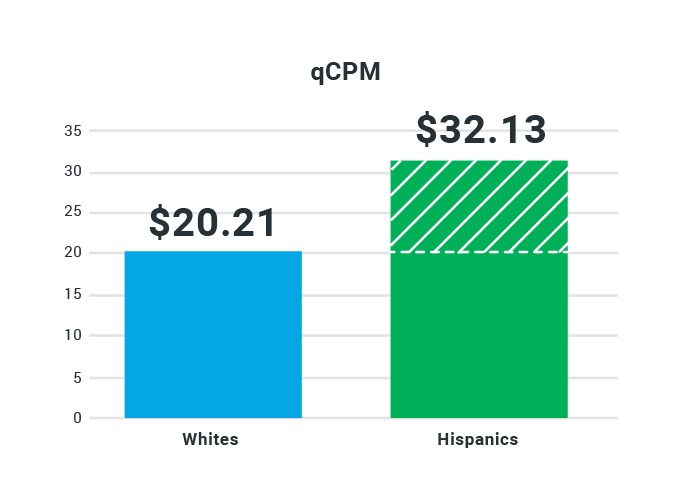
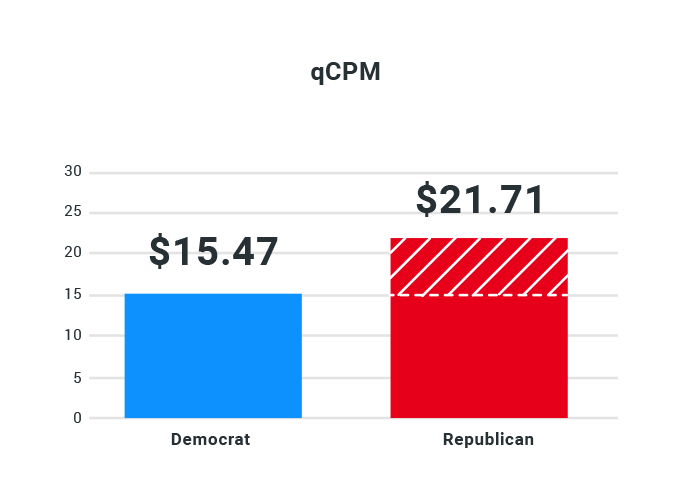
Conclusion:
Mass Messaging Doesn’t Work Equally Across American Race & Political Segments, Especially During A Pandemic Amidst Times of Shifting Sentiment
The distinct variation among ad scores when viewed by different racial groups suggests that the fragmentation of values, reasoning, emotion, and personal motivation makes it difficult to create effective public service ads amidst a pandemic in a highly polarized political climate. Ad production lead times contribute to the difficultly of creating messages that will still be resonant between the time of scripting and airing.
The Morgan Freeman single shot Zoom-like ad “Be there. This is your shot” from the Creative Coalition indicates that low-budget creative formats can succeed in attracting attention. Our study, “Tik Tok and the power of authenticity,” showed that Tik Tok videos outperformed other ad formats in driving attention in mobile. Authentic messages from respected individuals—in addition to the “I’m vaccinated” posts that flooded personal social media feeds in recent months—may be just as effective as driving vaccine uptake.
As the United States approaches herd immunity, there may be future scenarios in which people need another vaccine or vaccine booster. PSAs need to address multiple resistance factors while imparting emotional drivers to encourage action. To address this challenge, a variety of low-budget, targeted ads and media buys, along with grass-roots marketing, may be the best approach.
Finally, smart advertisers should use available tools to predict and model the cost of attention outcomes with their creative and media across different audience segments. And they should do so and make optimizations before their campaigns even launch.
Contents:
- Executive Summary: What You Need to Know
- Background: Vaccine Rollout 2021
- Methodology and Definitions
- Vaccine Ads Engage Democrats Better Than Republicans
- Government, Health, and Pharma Advertisers Must Tailor Messaging & Targeting
- Ad Performance by Race
- Influence of Creative On Effective Media Cost
- Conclusion
Share this:
